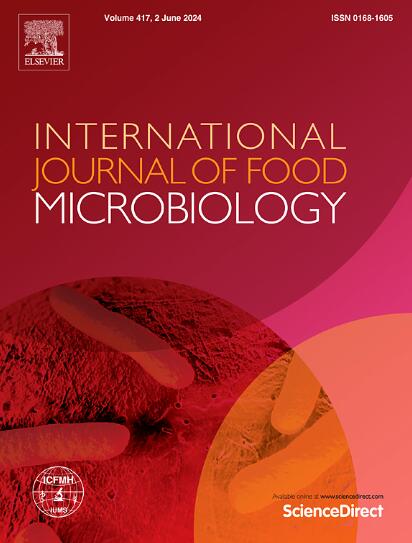单核细胞增生李斯特菌生物膜和浮游细胞在熟火腿污染-储存-消化过程中的存活
IF 5
1区 农林科学
Q1 FOOD SCIENCE & TECHNOLOGY
International journal of food microbiology
Pub Date : 2025-07-12
DOI:10.1016/j.ijfoodmicro.2025.111346
引用次数: 0
摘要
2023年,李斯特菌病在欧洲显著增加,有2952例侵袭性病例,死亡率为19.70%,是被确定为最受影响的即食食品类别。本研究主要研究单核增生乳杆菌在食品污染-储存-消化过程中的存活。为此,用生物膜或浮游细胞人工污染煮熟的火腿,然后在7°C真空包装储存7天,并进行体外消化。在污染-储存-消化过程的不同阶段进行计数分析。从生物膜转移90 s的熟火腿污染显示出菌株间的变异,全球转移率为14.07%。在食物上,单核增生乳杆菌从初始浓度3.53 log CFU/cm2开始,在贮存期间生长≈0.5 log。在有或没有储存的污染食品的体外消化中,结果降低了≈−0.5 log。在浮游细胞的情况下,体外消化后的浓度与储存的函数有很大的差异(与没有储存或有储存的初始浓度相比,分别降低≈−2.1 log或≈−0.6 log)。有趣的是,在食物储存和消化后发现了意想不到的高浓度病原体。浮游细胞在污染食品的贮存过程中形成生物膜是合理的。在任何情况下,在储存和消化后观察到大量变异,L196是最具抗性的菌株。需要更多的组学科学研究来阐明单核细胞增生乳杆菌的行为。本文章由计算机程序翻译,如有差异,请以英文原文为准。

Survival of Listeria monocytogenes biofilms and planktonic cells on cooked ham in a contamination-storage-digestion process
In 2023, listeriosis experienced a significant increase in Europe, with 2952 invasive cases and 19.70 % mortality rate, being the ready-to-eat foods category identified as the mostly involved. This study focused on the survival of L. monocytogenes through a process of food contamination-storage-digestion. For this, cooked ham was artificially contaminated with biofilm or planktonic cells, followed or not by vacuum-packed storage at 7 °C for 7 days, and submitted to in vitro digestion. Enumeration analysis was performed at different stages during the contamination-storage-digestion process. Contamination of cooked ham by 90-s transfer from biofilm revealed inter-strain variability, with a global transfer rate of 14.07 %. On the food, L. monocytogenes grew ≈0.5 log during storage from an initial concentration of 3.53 log CFU/cm2. In vitro digestion of contaminated food with or without storage, resulted in a reduction of ≈−0.5 log. In the case of planktonic cells, great differences were found after in vitro digestion as a function of storage (≈−2.1 log or ≈−0.6 log reduction from the initial concentration without or with storage, respectively). Interestingly, an unexpectedly high concentration of the pathogen was found after food storage and digestion. It is plausible that a biofilm was formed during storage of the contaminated food with planktonic cells. In any case, high variability in numbers was observed after storage and digestion, being L196 the most resistant strain. More research in omics sciences is needed to clarify L. monocytogenes behaviour.
求助全文
通过发布文献求助,成功后即可免费获取论文全文。
去求助
来源期刊
CiteScore
10.40
自引率
5.60%
发文量
322
审稿时长
65 days
期刊介绍:
The International Journal of Food Microbiology publishes papers dealing with all aspects of food microbiology. Articles must present information that is novel, has high impact and interest, and is of high scientific quality. They should provide scientific or technological advancement in the specific field of interest of the journal and enhance its strong international reputation. Preliminary or confirmatory results as well as contributions not strictly related to food microbiology will not be considered for publication.

 求助内容:
求助内容: 应助结果提醒方式:
应助结果提醒方式:


